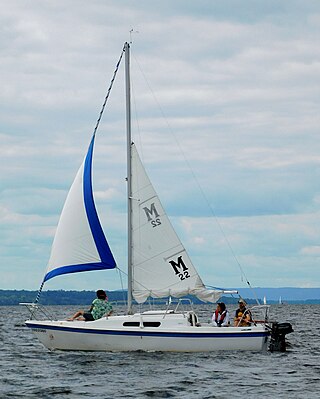Related Research Articles

The Rhodes 22, also referred to as the Rhodes 22 Continental, is an American trailerable sailboat that was designed by Philip Rhodes as a cruiser and first built in 1968.
The Triton 22 is an American trailerable sailboat, that was designed by Gary Mull and first built in 1985. The design is out of production.
The Bristol Caravel 22, sometimes called the Bristol 22 Caravel, Sailstar Caravel, or just the Caravel 22, is an American trailerable sailboat that was designed by Halsey Chase Herreshoff as a cruiser and first built in 1968. It is named for the class of sailing ship.
The Buccaneer 210 is an American trailerable sailboat that was designed by Alan Payne as a cruiser and first built in 1974.
The Buccaneer 240 and Buccaneer 245 are a family of American trailerable sailboats that were both designed as cruisers and first built in 1975.
The Captiva 240 is an American trailerable sailboat that was first built in 1984. The boat is a development of the O.H. Rodgers-designed Rodgers 24 racer, modified for use as a racer-cruiser by Walter Scott by giving it a new keel and sailing rig.
The Corinthian 19, also called the Bristol 19, is an American trailerable sailboat that was designed by Carl Alberg as a cruiser and first built in 1966.
The Coronado 23, also called the Sailcrafter 23, is an American trailerable sailboat that was designed by William Crealock as cruiser-racer and first built in 1969.
The Coronado 25 is an American trailerable sailboat that was designed by Ed Edgar and Frank W. Butler as a cruiser and first built in 1966.
The Irwin 23 is an American trailerable sailboat that was designed by Ted Irwin as a cruiser and first built in 1968.
The Irwin 25 is an American trailerable sailboat that was designed by Ted Irwin as a cruiser and first built in 1969.
The Islander 21 is an American trailerable sailboat that was designed by Joseph McGlasson as a pocket cruiser and first built in 1965.

The MacGregor 22 is an American trailerable sailboat that was designed by Roger MacGregor as a cruiser and first built in 1967.
The Morgan 22 is an American trailerable sailboat that was designed by Charley Morgan as a racer-cruiser and first built in 1968.
The Vivacity 24 is a British trailerable sailboat that was designed by Alan F. Hill as a cruiser and first built in 1969.
The S2 7.0 is an American trailerable sailboat that was designed by Arthur Edmunds as a cruiser and first built in 1975. The designation indicates the approximate length overall in meters.
The Seafarer 24 is an American trailerable sailboat that was designed by McCurdy & Rhodes as a cruiser and first built in 1974.
The Venture 22 is an American trailerable sailboat that was designed by Roger MacGregor as a cruiser and first built in 1968.
The Venture 222 is an American trailerable sailboat that was designed by Roger MacGregor as a cruiser and first built in 1971.
The Windrose 24 is an American trailerable sailboat that was designed by W. Shad Turner as a cruiser and first built in 1974.
References
- 1 2 3 4 5 6 McArthur, Bruce (2020). "Bristol 24 Corsair (Sailstar) sailboat". sailboatdata.com. Archived from the original on 20 January 2021. Retrieved 20 January 2021.
- 1 2 3 4 5 6 McArthur, Bruce (2020). "Corsair 24 (Sailstar) sailboat". sailboatdata.com. Archived from the original on 20 January 2021. Retrieved 20 January 2021.
- ↑ McArthur, Bruce (2020). "Paul Coble 1923 -". sailboatdata.com. Archived from the original on 20 January 2021. Retrieved 20 January 2021.
- 1 2 3 4 5 6 7 8 Henkel, Steve: The Sailor's Book of Small Cruising Sailboats, page 325. International Marine/McGraw-Hill, 2010. ISBN 978-0-07-163652-0
- ↑ McArthur, Bruce (2020). "Sailstar Boat Co. (USA) 1960 - 1971". sailboatdata.com. Archived from the original on 3 January 2021. Retrieved 20 January 2021.
- ↑ McArthur, Bruce (2020). "Bristol Yachts 1964 - 1997". sailboatdata.com. Archived from the original on 19 January 2021. Retrieved 20 January 2021.
- ↑ Shaw, Liz (January 2005). "Sturdy As She Goes". Cruising World. Retrieved 20 January 2021.
- ↑ "Bristol 24". Blue Water Boats. 2020. Archived from the original on 21 January 2021. Retrieved 15 January 2021.